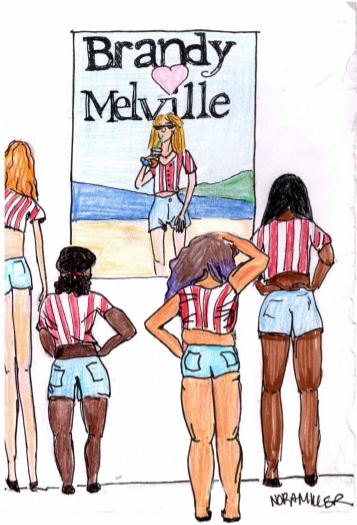We need a more inclusive clothing industry
April 26, 2019
Brandy Melville is famous for its cute graphic tees, plaid skirts and laid back style. But it’s also famous for something not so cute– all of its clothes are one size.
Everything except for the some of the bottoms at Brandy Melville are only sold in one size. On their website, although some hoodies are labeled to fit a size small/medium, all shirts are labeled to fit a size x-small or small. Some pants are sold in a size small or medium, but there is no set waist dimension for either of those sizes; a size medium can range up to about a 30” waist to any waist size below.
Although Brandy Melville is only selling clothes to a select group of consumers, with 3.8 million Instagram followers as of April 21, 2019, they are far from unpopular. By targeting an audience of young women, Brandy Melville has branded an exclusive shopping experience that can be traumatic for young women who cannot wear their clothes.
“I think brands like Brandy Melville contribute to [negative body image] because once those popular brands say ‘you can only wear our clothes if you look this certain way, and sometimes ‘when you look this way you still can’t wear our clothes’, it’s going to make people feel bad about themselves,” freshman Ella Greenberg Winnick says.
Size exclusive brands such as Brandy Melville have a detrimental effect on the body image of teenage girls. To find out a popular brand won’t produce items in your size can make girls think more negatively about their body, or even feel like their body may not be deserving of the clothes they like.
According to the Park Nicollet Melrose Center, 53% of 13 year old girls are unhappy with their bodies. By the time girls reach 17, this number rises to 78%. Young women already can’t afford to be dealing with such exclusive popular brands when the percentage of girls who are unhappy with their bodies is so high.
Negative self image is also problematic for the mental well-being of teenage girls, which has negative effects on physical health as well. According to the National Eating Disorder Association, nearly 20 million women have been diagnosed with an eating disorder in recent years.
For the mental and physical well being of teenage girls, the clothing industry needs to be more inclusive. Young women are constantly being told by the media the way they should look, and exclusive sizing in clothing brands is just another way to further that message.
Despite the exclusivity of some brands, others are doing exactly the opposite: creating a more encouraging experience for shoppers by employing more models that truly represent their audience and expanding their size range to accommodate a wider base of consumers.
In 2014, Aerie, the American Eagle lingerie brand, launched their Aerie Real campaign, promising to not use photoshop to doctor up the pictures of their models. To further their campaign, Aerie hired 57 “non-traditional” models in 2018. By doing so, the Aerie Real campaign is finally allowing the public to see themselves in their clothes. The reality is, a very small percentage of women and teenage girls really look like the models they constantly see.
According to Mirror Mirror, an organization for eating disorder help, “If we consider society’s idea of the perfect body image for women based on the average fashion model, we would think that the perfect woman was about 5’10” and weighs only 120 pounds. However, the National Center for Health Statistics reports that the average American woman is only about 5’4” and weighs about 169 pounds.”
While a lot of models are a reflection of the “perfect woman”, beauty should not be defined as one standard. With campaign slogans such as “Don’t Change You. Change Your Bra!”, Aerie is fostering the idea that young women don’t need to change themselves; the clothing industry needs to be more accepting of all body types.
Besides Aerie, companies such as Savage x Fenty, Asos, and Madewell, among others, are helping to create a healthier and more inclusive clothing industry by producing extended sizes of their products.
“I think that for as long as people can remember, the models have been super tall, super skinny, and they’re usually white,” Greenberg Winnick says. “[More inclusive models] would just make people be like ‘oh I can see myself as pretty now’ and ‘I can see myself as someone who can wear these clothes and dress a certain way’ because if all the models look the same, they don’t really represent who’s watching them.”
If teenage girls are never able to see themselves in the clothing industry, then it sends the message that because they don’t look like the traditional idea of a model, they are not considered beautiful and they are not as valued as the “classic” European standard of beauty.
Although the controversy around Brandy Melville has been predominantly focused on size, the fashion industry has historically struggled with representation of different bodies and races, among other complexities of their consumers. Consumers have to stay engaged in order to see lasting changes in the clothing industry.
So please, if you don’t support brands with exclusive sizes, or if you don’t fit into the sizes at Brandy Melville or other exclusive clothing brands, take your money elsewhere. By doing so, you will be supporting another brand that’s uplifting for young women and creating a healthier clothing industry.





















